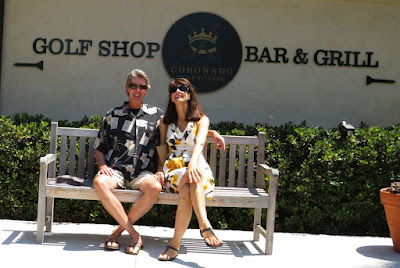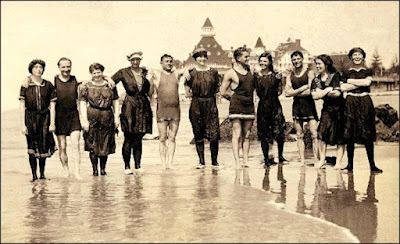Our Day on Coronado Island...
Sit back with a cup of coffee. This is going to be a long post. I can't help myself, we experienced (and learned) so much while there. WOW.
Our first stop was at the picturesque Coronado Library. Founded in 1890, John D. Spreckels built this, the library's first official building, in 1909.
That building is now known as the Spreckels Reading Room. Mr. Spreckels will be mentioned again. What a guy!
I am a fan of James Bond Stockdale (December 23, 1923 – July 5, 2005), a United States Navy vice admiral and aviator awarded the Medal of Honor in the Vietnam War, during which he was a prisoner of war for over seven years. He went on to do some amazing things, including living on Coronado and having a very intriguing book collection.
I like Admiral Stockdale even more when I saw several books of his on the fine art of bookbinding!
Our next stop was the Coronado Historical Society Museum.
Here we received an introduction to the Island's star, the Hotel Del Coronado.
A living legend for more than 130 years, The Del celebrates its rich history as the proud host to celebrities, royalty, U.S. Presidents, and beach-loving guests for generations. Built in 1888 by Elisha Babcock, Jr., and Hampton L. Story, this famous beach resort is a San Diego icon. More about that when we arrive after lunch.
Steve found us the most idyllic lunch spot, Feast & Fareway at the Coronado Golf Course.
I think this might be my new favorite spot to dine.
We spotted this groovy hotel the Villa Capri, directly across from The Del.
Its neon signs were installed in 1956, when the motel was constructed, and were designated as a Historic Resource in 1988. They are historically significant as a Special Element of the City's cultural and architectural history, and are examples of Mid-Century Modern neon signage. Sweet!
We just found something new and we were excited to explore "the 1889 Ice House Museum to discover the behind-the-scenes history of The Del, along with its world-famous dining, recreation and legendary guests. Featuring artifacts, memorabilia, and a Marilyn Monroe selfie spot, the Museum is also where all of our history tours begin. The Museum is located next to the Power Plant on Wagers Row, the row of historic buildings along the main drive. Admission is complimentary."
Here we found more history of this amazing resort. Hotel founders, Babcock and Story, along with San Diego developer Alonzo Horton, surveyed Coronado beach in 1886. Although neither Babcock nor Story had experience in the hotel business, they were so inspired by the natural beauty of Coronado that they decided to buy the island and build a magnificent hotel, one that would be “the talk of the western world,” an iconic California destination where “people will continue to come long after we are gone."
The founders first created the Coronado Beach Company, after which they established a number of additional enterprises to support the development of the Coronado community (a ferry company, water company, railroad company and an electrical power plant). As soon as a site was chosen for the historic Hotel, the men laid out Coronado’s parks, civic areas, commercial zones and streets (Isabella and Adella avenues were named for the founders’ wives).
Once the town was established, it was time to attract residents, so Babcock and Story held a very well-publicized land auction, which attracted a reported 6,000 people. 350 lots were sold during the auction, raising about $100,000. By June 10, 1887, Coronado lot sales had reached the $1.5 million mark. The grand total would eventually reach $2.25 million.
Although guests began arriving as early as late January 1888, Hotel del Coronado’s birthday has generally been celebrated on February 19 – the day the historic Southern California hotel served its first meal in the main dining room (today’s Crown Room). An early promotional brochure described the many amenities of the new destination, including its interior court with a fountain and exotic fruit trees, luxury guestrooms overlooking the garden patio or exterior vistas, private parlors, reception rooms, music and billiard rooms, expansive verandas and was promoted as a health resort for its abundant sunshine and restorative ocean air. Room rates – which included three meals a day – started at about $2.50 per day. The hotel was built at a cost of $600,000 and furnished for $400,000.
Interspersed with the history of the hotel were stories of the people who came to visit. This photo, taken in 1915, consists of some pretty powerful men, Harvey Firestone, Henry Ford, Thomas Edison and John Burroughs (author of Tarzan).
Interestingly, between 1915 and 1924, Ford, Edison, Firestone, and Burroughs, calling themselves the Four Vagabonds, embarked on a series of summer camping trips. The idea was initiated in 1914, when Ford and Burroughs visited Edison in Florida and toured the Everglades. The notion blossomed the next year when Ford, Edison and Firestone were in California for the Panama-Pacific Exposition. They visited Luther Burbank and then drove from Riverside to San Diego. Wild, right? Who knew?
On April 7, 1920, England's Edward, Prince of Wales (later King Edward) was feted at a reception and dinner in the Crown Room. An estimated 1,000 guests dined on filet mignon and baked Alaska followed by dancing in the Ballroom. Contrary to legend, Edward did not meet his future wife, Wallis Warfield Spencer Simpson, who was living in Coronado in 1920, at the event. In 1936, Edward would abdicate the English throne in order "to marry the woman I love."
These are the dishes from that elaborate meal.
Was Walt here on a mission? Turns out that the Hotel Del Coronado was the inspiration for Walt Disney World's Grand Floridian Resort. So cool. I love any Disney connection I can get.
When Hotel del Coronado debuted, it was considered a technological marvel. Electricity was still a novelty in 1888, and The Del was thought to be one of the largest buildings in the country to have been “electrified” (contrary to popular belief, Thomas Edison did not install The Del’s electrical system). The Del also supplied electricity to the city of Coronado. Other technological assets of the newly constructed California resort included steam-powered hydraulic elevators (among the first in the country), a state-of-the-art fire sprinkler system, and telephone service, which had reached San Diego only seven years earlier.
The Del's most prominent stained-glass window – located on the front façade – garners a great deal of attention from visitors. Original to the hotel, the window was first mounted in the massive lobby chimney, visible from the front exterior as well as the lobby interior. After the fireplace was removed in the 1920s, the famous stained glass was displayed in a variety of interior locations. In 1995, it was moved to the fourth floor exterior, above the lobby entrance. In 2020, the piece was carefully removed for a complete restoration and was just returned to its original second-story days before we arrived. Architect James Reid described the stained-glass scene as an “allegorical representation of Coronado” with a landscape background “representing mountains, valleys and a bay.”
The Crown Room was considered an architectural achievement spanning 160 feet by 60 feet, without any pillars to interrupt the view. This iconic San Diego venue is also famous for its 33 foot high ceiling, paneled in beautiful Oregon sugar pine. Wizard of Oz author L. Frank Baum is credited for designing the famous crown chandeliers, which were installed in 1911.
From 1900 until 1938, The Del's Tent City was a popular camp-style destination for travelers to Coronado Island who couldn't afford to stay in the big hotel. Designed like a small city, its grid of dirt streets eventually became well-worn thoroughfares, lined with mature trees, with up to 1,000 tents. An early getaway brochure described the accommodations: “A furnished tent comprises electric lights, matting on boarded floor, comfortable beds and cots, bedding, wash-stand, mirror, tables, chairs, rockers, camp-chairs and stools, necessary cooking utensils, clean linen, daily care of tent, and laundry service of tent linen.” I would so stay there.
In 1904, The Del – already considered a technological marvel – made history when it unveiled the world’s first electrically lit, outdoor, living Christmas tree. Holiday lights were strung from the hotel to a nearby Norfolk Island Pine. Although indoor trees were popular in America by this time, electric Christmas lights were a rarity (candles were still commonplace).
For an all wood hotel, fire suppression had to be on everyone's mind, always! This 1910 photo depicts a fire drill.
How cool that one of the original fire extinguishers is still on property. It helps give perspective to how truly dangerous it could have been.
Remember the guy who provided the city with its library? Well, when the resort was under construction, an economic downturn sent many investors out of San Diego and The Del's founders were concerned. John D. Spreckels, son of wealthy Sugar King Claus Spreckels, fell in love with the Hotel del Coronado and provided generous loans and other assistance to the resort's founders, in order to keep the dream alive. Ultimately, the two businessmen chose to transfer complete ownership to Spreckels. He remained owner until his death in 1926, and the hotel remained in his family until 1948.
Our last stop of the day was to learn about this son of the Sugar King. John Dietrich Spreckels did more than any other individual in San Diego's history to help the city prosper. His visionary leadership helped put San Diego on the map of national and international commerce.
Spreckels dedicated much of his energy to building San Diego, but his love was Coronado Island. As a part of his many acquisitions, Spreckels invested $500,000 in the Coronado Beach Company (1890). Within the next decade he owned all but five parcels of Coronado Island and North Island. Spreckels gave the city its library, several parks and its largest commercial building, the Spreckels Building on Orange Avenue.
John D. Spreckles and family lived here, where he built his dream home on five acres of land overlooking Glorietta Bay, directly across from the Hotel del Coronado. In 1906, he contracted architect Harrison Albright to design and build the Mansion. The building, designed with the simple, classic lines of Italian Renaissance, was complete in 1908 with six bedrooms, three baths, a parlor, dining room and library, at the cost of $35,000. At that time, Spreckels' Mansion featured a brass cage elevator, a marble staircase with leather-padded handrails, skylights, marble floors and some of the Island's most spectacular gardens. The home was built with reinforced steel and concrete, an earthquake precaution Spreckels insisted upon after living through the 1906 San Francisco earthquake.
Over the years, the house changed hands and is now the Glorietta Bay Inn. We rested in Mr. Spreckels' horseshoe-shaped Music Room, with nine French doors which lead out to a patio. It was here that we ended our Coronado day and vowed to return soon to the Crown City to explore and learn. Fun day by the bay!










































1 comments:
Well that’s a never ending day! San Diego is so much fun. I will have to check out the Coronado Library. It looks amazing. I would have loved to see the it back in the day.
Post a Comment